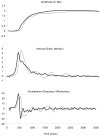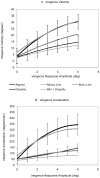The first and second order dynamics of accommodative convergence and disparity convergence
- PMID: 20561972
- PMCID: PMC2967359
- DOI: 10.1016/j.visres.2010.05.029
The first and second order dynamics of accommodative convergence and disparity convergence
Abstract
Main sequences, the function describing the relationship between eye movement amplitude and velocity, have been used extensively in oculomotor research as an indicator of first-order dynamics yet it is difficult to find main sequence analyses for accommodative vergence or for disparity vergence in isolation when all mitigating factors have been well controlled and there are no studies in which accommodative vergence and disparity vergence main sequences have been generated for the same group of subjects. The present study measured main sequences in: (1) accommodative vergence with disparity vergence open loop, (2) disparity vergence with accommodation open loop, and (3) combinations of accommodative and disparity vergence. A dynamic AC/A ratio was defined and was found to be similar to the traditional static AC/A ratio. Vergence acceleration was measured for all conditions. A pulse-step model of accommodation and convergence was constructed to interpret the dynamics of the crosslinked interactions between the two systems. The model supports cross-coupling of both the pulse and step components and simulates the primary empirical findings that: (1) disparity vergence has a higher main sequence slope than accommodative vergence, (2) both accommodative and disparity vergence acceleration increase with response amplitude whereas accommodation acceleration does not.
Copyright 2010 Elsevier Ltd. All rights reserved.
Figures











Similar articles
-
Short-term adaptation of accommodation, accommodative vergence and disparity vergence facility.Vision Res. 2012 Jun 1;62:93-101. doi: 10.1016/j.visres.2012.03.013. Epub 2012 Mar 29. Vision Res. 2012. PMID: 22480879 Free PMC article.
-
A dynamic model of cross-coupling between accommodation and convergence: simulations of step and frequency responses.Optom Vis Sci. 1992 Apr;69(4):258-69. doi: 10.1097/00006324-199204000-00002. Optom Vis Sci. 1992. PMID: 1565425 Review.
-
The accommodative contribution to binocular vergence eye movements.Ophthalmic Physiol Opt. 1989 Oct;9(4):379-84. Ophthalmic Physiol Opt. 1989. PMID: 2631003
-
Influence of proximal, accommodative and disparity stimuli upon the vergence system.Ophthalmic Physiol Opt. 1993 Jul;13(3):239-43. doi: 10.1111/j.1475-1313.1993.tb00465.x. Ophthalmic Physiol Opt. 1993. PMID: 8265164
-
The Glenn A. Fry award lecture: adaptive regulation of accommodative vergence and vergence accommodation.Am J Optom Physiol Opt. 1986 Aug;63(8):587-609. Am J Optom Physiol Opt. 1986. PMID: 3532810 Review.
Cited by
-
The influence of age on adaptation of disparity vergence and phoria.Vision Res. 2017 Apr;133:1-11. doi: 10.1016/j.visres.2017.01.002. Epub 2017 Feb 17. Vision Res. 2017. PMID: 28192091 Free PMC article.
-
Eye posture and screen alignment with simulated see-through head-mounted displays.J Vis. 2025 Jan 2;25(1):9. doi: 10.1167/jov.25.1.9. J Vis. 2025. PMID: 39786732 Free PMC article.
-
A covered eye fails to follow an object moving in depth.Sci Rep. 2021 May 26;11(1):10983. doi: 10.1038/s41598-021-90371-8. Sci Rep. 2021. PMID: 34040063 Free PMC article.
-
Efferent compared to afferent neural substrates of the vergence eye movement system evoked via fMRI.Front Neurosci. 2025 Jan 8;18:1497326. doi: 10.3389/fnins.2024.1497326. eCollection 2024. Front Neurosci. 2025. PMID: 39844855 Free PMC article.
-
Quantification of Oculomotor Responses and Accommodation through Instrumentation and Analysis Toolboxes.J Vis Exp. 2023 Mar 3;(193):10.3791/64808. doi: 10.3791/64808. J Vis Exp. 2023. PMID: 36939267 Free PMC article.
References
-
- Alpern M, Ellen P. A quantitative analysis of the horizontal movements of the eyes in the experiment of Johannes Mueller. I. Method and results. Am J Ophthalmol. 1956a;42(4 Part 2):289–296. - PubMed
-
- Alpern M, Ellen P. A quantitative analysis of the horizontal movements of the eyes in the experiment of Johannes Mueller. II. Effect of variation in target separation. Am J Ophthalmol. 1956b;42(4 Part 2):296–303. - PubMed
-
- Alvarez TL, Semmlow JL, Yuan W, Munoz P. Dynamic details of disparity convergence eye movements. Ann Biomed Eng. 1999;27(3):380–390. - PubMed
-
- Alvarez TL, Semmlow JL, Yuan W, Munoz P. Comparison of disparity vergence system responses to predictable and non-predictable stimulations. Current Psychology of Cognition. 2002;21(2–3):243–261.
-
- Busettini C, Mays LE. Saccade-vergence interactions in macaques. I. Test of the omnipause Multiply Model. J Neurophysiol. 2005a;94(4):2295–2311. - PubMed
MeSH terms
Grants and funding
LinkOut - more resources
Full Text Sources

